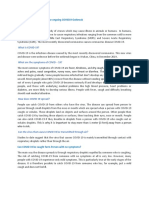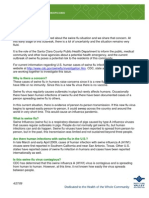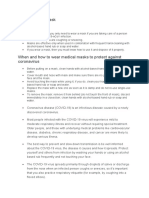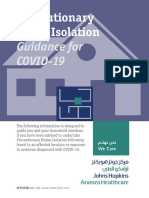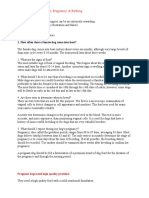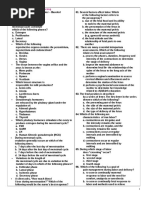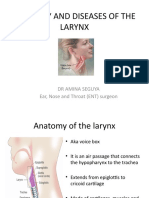Influenza A H1N1 Flu (Swine Flu) Symptoms
Influenza A H1N1 Flu (Swine Flu) Symptoms
Uploaded by
male nurseCopyright:
Available Formats
Influenza A H1N1 Flu (Swine Flu) Symptoms
Influenza A H1N1 Flu (Swine Flu) Symptoms
Uploaded by
male nurseOriginal Description:
Original Title
Copyright
Available Formats
Share this document
Did you find this document useful?
Is this content inappropriate?
Copyright:
Available Formats
Influenza A H1N1 Flu (Swine Flu) Symptoms
Influenza A H1N1 Flu (Swine Flu) Symptoms
Uploaded by
male nurseCopyright:
Available Formats
Information for Infleunza A (H1N1)
Quarantine Guidelines for cases & contacts
Influenza A H1N1 Flu (Swine Flu)
Symptoms:
Influenza A virus infection (swine flu) can cause a wide range of symptoms, including
fever
cough,
sore throat
body aches, headache
chills and
fatigue.
Some people have reported diarrhea and vomiting associated with swine flu.
How Flu Spreads:
The main way that influenza viruses are thought to spread is from person to person in respiratory
droplets of coughs and sneezes. Influenza viruses may also be spread when a person touches
respiratory droplets on another person or an object and then touches their own mouth or nose (or
someone elses mouth or nose) before washing their hands.
What is Quarantine:
Quarantine means restricting the movements of some people (contacts) who are well but who
have been in close contact with another person (a case) who has or who is strongly suspected to
have an infectious disease.
Duration of quarantine:
You are required to stay in isolation for 7 days from symptom onset or until the resolution of
symptoms, whichever is longer.
What must I do when I am being quarantined:
While under quarantine, you must:
Stay at home throughout the quarantine period which is 7 days after your symptoms begin or until you
have been symptom-free for 24 hours, whichever is longer.
CDC HOT LINE: 6740-948 / 9740-951
DPH,SCH
Information for Infleunza A (H1N1)
Quarantine Guidelines for cases & contacts
Remain contactable at all times. The CDC staff will be calling you randomly to check on your health.
Monitor your temperature and the temperature of all your household members for the duration of the
quarantine period.
Minimize contact with family members and other persons who reside in your home (i.e. stay in a
separate room and use a separate bathroom where possible).
Wear a surgical mask if you need to be in a common area of the house near other persons.
Practice good personal hygiene (i.e. cover nose and mouth when coughing or sneezing)
Clean hands with soap and water or an alcohol-based hand rub often and especially after
using tissues and after coughing or sneezing into hands.
Respond fully and truthfully to all questions put to you by Supreme Council of Health Officers and any
other persons acting on behalf of the Director of Medical services.
What should I do if my family members or I become unwell during the quarantine period?
If any one develops flu-like symptoms such as fever of 38C or higher, cough, sore throat, runny
nose and shortness of breath, inform the CDC Hotline (6740-948 or 6740-951) or the HMC
hotline (443-0348).
Steps to Lessen the Spread of Flu in the Home
When providing care to a household member who is sick with influenza, the most important
ways to protect yourself and others who are not sick are to:
keep the sick person away from other people as much as possible (see placement of the
sick person)
remind the sick person to cover their coughs, and clean their hands with soap and water
or an alcohol-based hand rub often, especially after coughing and/or sneezing.
have everyone in the household clean their hands often, using soap and water or an
alcohol-based hand rub
Placement of the sick person
Keep the sick person in a room separate from the common areas of the house. (For
example, a spare bedroom with its own bathroom, if thats possible.) Keep the sickroom
door closed.
CDC HOT LINE: 6740-948 / 9740-951
DPH,SCH
Information for Infleunza A (H1N1)
Quarantine Guidelines for cases & contacts
Unless necessary for medical care, persons with the flu should not leave the home when
they have a fever or during the time that they are most likely to spread their infection to
others
If persons with the flu need to leave the home (for example, for medical care), they
should cover their nose and mouth when coughing or sneezing and wear a loose-fitting
(surgical) mask if available.
Have the sick person wear a surgical mask if they need to be in a common area of the
house near other persons.
If possible, sick persons should use a separate bathroom. This bathroom should be
cleaned daily with household disinfectant.
Protect other persons in the home
The sick person should not have visitors other than caregivers. A phone call is safer than
a visit.
If possible, have only one adult in the home take care of the sick person.
All persons in the household should clean their hands with soap and water or an alcoholbased hand rub frequently, including after every contact with the sick person or the
persons room or bathroom.
If possible, consideration should be given to maintaining good ventilation in shared
household areas (e.g., keeping windows open in restrooms, kitchen, bathroom, etc.).
If you are the caregiver
Avoid being face-to-face with the sick person.
When holding small children who are sick, place their chin on your shoulder so that they
will not cough in your face.
Clean your hands with soap and water or use an alcohol-based hand rub after you touch
the sick person or handle used tissues, or laundry.
Monitor yourself and household members for flu symptoms and contact a CDC
hotline or health care provider if symptoms occur.
CDC HOT LINE: 6740-948 / 9740-951
DPH,SCH
Information for Infleunza A (H1N1)
Quarantine Guidelines for cases & contacts
Using Facemasks or Respirators
Avoid close contact (less than about 6 feet away) with the sick person as much as
possible.
If you must have close contact with the sick person (for example, hold a sick infant),
spend the least amount of time possible in close contact and try to wear a facemask (for
example, surgical mask) or N95 disposable respirator.
Used facemasks and N95 respirators should be taken off and placed immediately in the
regular trash so they dont touch anything else.
Avoid re-using disposable facemasks and N95 respirators if possible. If a reusable fabric
facemask is used, it should be laundered with normal laundry detergent and tumble-dried
in a hot dryer.
After you take off a facemask or N95 respirator, clean your hands with soap and water or
an alcohol-based hand sanitizer.
Signs that warrant seeking urgent medical attention:
For children:
Fast breathing or trouble breathing,
Bluish or gray skin color,
Not drinking enough fluids,
Severe or persistent vomiting,
Not waking up or not interacting,
Being so irritable that the child does not want to be held,
Flu-like symptoms improve but then return with fever and worse cough
For adults:
Difficulty breathing or shortness of breath,
Pain or pressure in the chest or abdomen,
Sudden dizziness, Confusion,
Severe or persistent vomiting,
Flu-like symptoms improve but then return with fever and worse cough
CDC HOT LINE: 6740-948 / 9740-951
DPH,SCH
Information for Infleunza A (H1N1)
Quarantine Guidelines for cases & contacts
Your health is in your hands
just remember to wash them
What you can do to stop the spread of germs
CDC HOT LINE: 6740-948 / 9740-951
DPH,SCH
You might also like
- "Mag HL Tayo": RationaleDocument2 pages"Mag HL Tayo": Rationalemale nurse75% (4)
- DOH Program Adolescent and Youth Health and Devt Progrma AYHDPDocument11 pagesDOH Program Adolescent and Youth Health and Devt Progrma AYHDPmale nurseNo ratings yet
- DOH Program Adolescent and Youth Health and Devt Progrma AYHDPDocument11 pagesDOH Program Adolescent and Youth Health and Devt Progrma AYHDPmale nurseNo ratings yet
- CD - 5th H1N1Document40 pagesCD - 5th H1N1Jannatul Adnin JinanNo ratings yet
- COVID 19 and Isolation MeasuresDocument39 pagesCOVID 19 and Isolation MeasuresJune KarkiNo ratings yet
- Influenza A Swine Flu PDFDocument21 pagesInfluenza A Swine Flu PDFryps01No ratings yet
- Swine Flu InfoDocument20 pagesSwine Flu InfoUdit SinghNo ratings yet
- COVID-19 Frequently Asked Questions FINALDocument4 pagesCOVID-19 Frequently Asked Questions FINALPriskilla Grace TicoaluNo ratings yet
- Action Plan For Corona Virus - 01Document12 pagesAction Plan For Corona Virus - 01இராம் குமார்No ratings yet
- Measures Taken by The School For Swine FluDocument4 pagesMeasures Taken by The School For Swine Fluhtc121No ratings yet
- WHO Information On Swine Flu - 27!04!09Document4 pagesWHO Information On Swine Flu - 27!04!09prabinchaNo ratings yet
- Moral ScienceDocument12 pagesMoral Sciencepratikjoshi86100% (1)
- April 27, 2009 Influenza Swine Flu For Tet's StaffDocument21 pagesApril 27, 2009 Influenza Swine Flu For Tet's Staffapi-25909027No ratings yet
- Protect Yourself From Swine Flu: Confidentiality Level: Confidentiality LevelDocument20 pagesProtect Yourself From Swine Flu: Confidentiality Level: Confidentiality LevelPurvish ShahNo ratings yet
- Protect Yourself From Swine Flu: Confidentiality Level: Confidentiality LevelDocument20 pagesProtect Yourself From Swine Flu: Confidentiality Level: Confidentiality Levelpurvish13No ratings yet
- Swine Flu InfoDocument22 pagesSwine Flu InfoyogasyrNo ratings yet
- How To Avoid Catching or Spreading CoronavirusDocument63 pagesHow To Avoid Catching or Spreading CoronavirusHari BabooNo ratings yet
- What Do During Pandemic ExplanationDocument5 pagesWhat Do During Pandemic Explanationshiella mae baltazarNo ratings yet
- Coronavirus 101 - What You Need To KnowDocument7 pagesCoronavirus 101 - What You Need To KnowParc ElyesNo ratings yet
- Covid-19 Instructions QuarantineDocument4 pagesCovid-19 Instructions QuarantineFrançois MartinsNo ratings yet
- Coronavirus Covid 19 Isolation Guidance - 7 PDFDocument2 pagesCoronavirus Covid 19 Isolation Guidance - 7 PDFyugobaekNo ratings yet
- COVIDconcernedDocument2 pagesCOVIDconcernedBoogie WritesNo ratings yet
- What Is Coronaviruses?: FAQ: Remedial Measure To The Ongoing COVID19 OutbreakDocument4 pagesWhat Is Coronaviruses?: FAQ: Remedial Measure To The Ongoing COVID19 OutbreakNeil RiveraNo ratings yet
- Swine Flu: Frequently Asked QuestionsDocument5 pagesSwine Flu: Frequently Asked QuestionsShaun LuehringNo ratings yet
- H1N1 Flu: What's The Latest?Document69 pagesH1N1 Flu: What's The Latest?PHNLeilaNo ratings yet
- Infection Control Child CareDocument1 pageInfection Control Child CareteddwosNo ratings yet
- Corona PreventionDocument14 pagesCorona PreventionMaksudur Rahman ShawonNo ratings yet
- HFMDDocument19 pagesHFMDukhtijuNo ratings yet
- Self-Isolation Guidance-Revised 5-7-20Document4 pagesSelf-Isolation Guidance-Revised 5-7-20api-244363080No ratings yet
- h1n1 Swine Flu PresentationDocument15 pagesh1n1 Swine Flu PresentationGiveAway0% (1)
- Understanding Recent Coronavirus Outbreak & Prevention TechniquesDocument15 pagesUnderstanding Recent Coronavirus Outbreak & Prevention TechniquesNachikethus NarayanNo ratings yet
- COVID Policy MasterDocument2 pagesCOVID Policy MasterameonthenetNo ratings yet
- General Occupational Health Advisory: COVID-19 Public Service Occupational Health Program (PSOHP), Health Canada Updated: 15 March 2020Document12 pagesGeneral Occupational Health Advisory: COVID-19 Public Service Occupational Health Program (PSOHP), Health Canada Updated: 15 March 2020sajjad shaheenNo ratings yet
- Resume 1. What Is Coronaviruses?Document8 pagesResume 1. What Is Coronaviruses?Taufiq RamadhaniNo ratings yet
- School Health Safety ProtocolsDocument8 pagesSchool Health Safety ProtocolsGarex Allan RotsapNo ratings yet
- Swine Flu InfoDocument20 pagesSwine Flu Infoik5610No ratings yet
- H1N1 051109Document15 pagesH1N1 051109Kjeneht MarkNo ratings yet
- How Does Coronavirus (COVID-19) Spread?: To Protect Yourself and Your FamilyDocument3 pagesHow Does Coronavirus (COVID-19) Spread?: To Protect Yourself and Your FamilyCarlos VergaraNo ratings yet
- Common ColdsDocument3 pagesCommon Coldsvaguilar.fnpNo ratings yet
- Varicella (Chicken Pox)Document6 pagesVaricella (Chicken Pox)Jhey MalanyaonNo ratings yet
- COVID 19 ProjectDocument4 pagesCOVID 19 ProjectSam SezNo ratings yet
- Presentation Covid-19 Awareness Session 09 March 2020Document36 pagesPresentation Covid-19 Awareness Session 09 March 2020Pir wahabNo ratings yet
- Microbiology Compilation (MRS Saliu)Document15 pagesMicrobiology Compilation (MRS Saliu)Nifemi AketanNo ratings yet
- How To Avoid Getting Chicken Pox While Helping An Infected PersonDocument10 pagesHow To Avoid Getting Chicken Pox While Helping An Infected PersonSai Krishna YellapuNo ratings yet
- L Hi Appt Results 11202020Document9 pagesL Hi Appt Results 11202020n98ssy2b64No ratings yet
- Guidelines On Preventive Measures To Contain Spread of COVID-19 in WorkplaceDocument10 pagesGuidelines On Preventive Measures To Contain Spread of COVID-19 in WorkplaceGEET SAWHNEYNo ratings yet
- 5 Things You Can DoDocument2 pages5 Things You Can DoJuliana PrizzkaNo ratings yet
- Corona 123Document4 pagesCorona 123Budi YarjoNo ratings yet
- Coronavirus Covid 19 Information About Home Isolation When Unwell Suspected or Confirmed CasesDocument3 pagesCoronavirus Covid 19 Information About Home Isolation When Unwell Suspected or Confirmed Casestom_crekNo ratings yet
- Covid 19Document19 pagesCovid 19smileherowarsNo ratings yet
- Informacion Sobre El CoronavirusDocument12 pagesInformacion Sobre El CoronavirusOswaldo Jose Araujo CuencaNo ratings yet
- WQ 3453446456Document1 pageWQ 3453446456ComagaNo ratings yet
- Guidence For Self-Quarantined IndividualsDocument3 pagesGuidence For Self-Quarantined Individualsapi-244363080No ratings yet
- Home Isolation Guidance EnglishDocument6 pagesHome Isolation Guidance EnglishPrince JoseNo ratings yet
- Please Note: The Georgia Division of Public HealthDocument3 pagesPlease Note: The Georgia Division of Public Healthkdealer358No ratings yet
- RetretDocument2 pagesRetretdfsfsdNo ratings yet
- LDH Monkeypox Patient Handout Awaiting Test ResultsDocument2 pagesLDH Monkeypox Patient Handout Awaiting Test ResultsdhikaverianNo ratings yet
- Influenza (Seasonal Flu)Document3 pagesInfluenza (Seasonal Flu)Abhishek KukretiNo ratings yet
- How To Prevent h1n1 PointDocument4 pagesHow To Prevent h1n1 PointNazmi ShamsuddinNo ratings yet
- Diphtheria how to recognize the disease, how to keep from catching it, how to treat those who do catch itFrom EverandDiphtheria how to recognize the disease, how to keep from catching it, how to treat those who do catch itNo ratings yet
- Coronavirus Prevention: How to Keep your Immune System Strong & Reduce your Risk of DiseaseFrom EverandCoronavirus Prevention: How to Keep your Immune System Strong & Reduce your Risk of DiseaseNo ratings yet
- PEDIATRIC FIRST AID: How to respond quickly when your child is in dangerFrom EverandPEDIATRIC FIRST AID: How to respond quickly when your child is in dangerNo ratings yet
- I Got the Flu! What is Influenza? - Biology Book for Kids | Children's Diseases BooksFrom EverandI Got the Flu! What is Influenza? - Biology Book for Kids | Children's Diseases BooksNo ratings yet
- Health Hazards of Chemicals Commonly Used On Military BasesDocument35 pagesHealth Hazards of Chemicals Commonly Used On Military Basesmale nurseNo ratings yet
- Nclex Tips - September 25, 2016Document1 pageNclex Tips - September 25, 2016male nurseNo ratings yet
- Referral Protocol For Camp ClinicDocument2 pagesReferral Protocol For Camp Clinicmale nurseNo ratings yet
- Nclex Tips - September 25, 2007Document19 pagesNclex Tips - September 25, 2007male nurseNo ratings yet
- Nurse Charting2Document7 pagesNurse Charting2male nurseNo ratings yet
- Pregnant Dog - Pregnancy Signs in Dogs - Dog Article On Pets - Ca What To Expect When Your Dog Is ExpectingDocument3 pagesPregnant Dog - Pregnancy Signs in Dogs - Dog Article On Pets - Ca What To Expect When Your Dog Is Expectingmale nurseNo ratings yet
- All About Breeding DogsDocument5 pagesAll About Breeding Dogsmale nurseNo ratings yet
- What Is FOURmula ONE For HealthDocument6 pagesWhat Is FOURmula ONE For Healthmale nurseNo ratings yet
- Maternity Nursing: Final CoachingDocument116 pagesMaternity Nursing: Final Coachingmale nurse0% (1)
- Maternity Edited2Document7 pagesMaternity Edited2male nurse0% (1)
- Maternity Nursing EditedDocument10 pagesMaternity Nursing Editedmale nurseNo ratings yet
- Identify The Three Different Phases of - Differentiate The Different COPAR - Relate The Different COPAR PROCESS inDocument17 pagesIdentify The Three Different Phases of - Differentiate The Different COPAR - Relate The Different COPAR PROCESS inmale nurseNo ratings yet
- Newborn ScreeningDocument31 pagesNewborn Screeningmale nurseNo ratings yet
- IMCI Q&A For Board ExamDocument12 pagesIMCI Q&A For Board Exammale nurseNo ratings yet
- 20 Health Statistics3Document23 pages20 Health Statistics3male nurse100% (1)
- National Healthy Lifestyle ProgramDocument6 pagesNational Healthy Lifestyle Programmale nurse0% (1)
- DOH - Disease and Health Condition AdvisoryDocument11 pagesDOH - Disease and Health Condition Advisorymale nurseNo ratings yet
- Common ColdDocument6 pagesCommon ColdRAM SOFTWARENo ratings yet
- Avian Flu: Emerging IllnessesDocument11 pagesAvian Flu: Emerging IllnessesPrincess Aliah M. MaruhomNo ratings yet
- Bronchiectasis - Ppt-Medina Presentation2Document25 pagesBronchiectasis - Ppt-Medina Presentation2chebetnaomi945No ratings yet
- Recognizing Interstitial Versus Airspace Disease: in Slide Show Mode, Advance The Slides by Pressing The SpacebarDocument32 pagesRecognizing Interstitial Versus Airspace Disease: in Slide Show Mode, Advance The Slides by Pressing The SpacebarCheska TumulakNo ratings yet
- HemoptysisDocument32 pagesHemoptysisbudiNo ratings yet
- Dapus LinaDocument3 pagesDapus LinaGrace Juniaty GozaliNo ratings yet
- Pink and Blue Lung Cancer Awareness Presentation - 20230808 - 202358 - 0000Document32 pagesPink and Blue Lung Cancer Awareness Presentation - 20230808 - 202358 - 0000ashmitav8m10402No ratings yet
- Course Task 3Document2 pagesCourse Task 3Geraldine MaeNo ratings yet
- Specimen: Test Result: DOROJA, Joseph Christopher GasconDocument2 pagesSpecimen: Test Result: DOROJA, Joseph Christopher GasconChristopher DorojaNo ratings yet
- Nursing Care Plan For PneumoniaDocument2 pagesNursing Care Plan For PneumoniaJonas Galeos100% (2)
- StridorDocument1 pageStridorhrg79qzwc2No ratings yet
- Anatomy and Diseases of The LarynxDocument19 pagesAnatomy and Diseases of The LarynxANENA RHODANo ratings yet
- Radiology HWDocument10 pagesRadiology HWБаяржавхлан СүхбаатарNo ratings yet
- L 5 - Lungs PathologyDocument128 pagesL 5 - Lungs PathologyDiana Popovici100% (1)
- IM Concept Map SGD Group 13, Fever and CoughDocument4 pagesIM Concept Map SGD Group 13, Fever and Coughb8gjhmq6rrNo ratings yet
- Physical Exam - Chest 2006Document84 pagesPhysical Exam - Chest 2006api-19916399No ratings yet
- Dyspnea: CausesDocument7 pagesDyspnea: CausesGetom NgukirNo ratings yet
- Nursing Care Plan CoughDocument2 pagesNursing Care Plan Coughderic90% (89)
- Respiratory Disorders: Dr. Fajar Wahyu PribadiDocument66 pagesRespiratory Disorders: Dr. Fajar Wahyu PribadiwinarsohNo ratings yet
- Bronchial Asthma!: A C E S G V CDocument10 pagesBronchial Asthma!: A C E S G V CAmalNo ratings yet
- Unit 10Document7 pagesUnit 10Andy R.GuerreroNo ratings yet
- National Tuberculosis and Lung Disease Conference 2024Document5 pagesNational Tuberculosis and Lung Disease Conference 2024Noor Shazana Mustaffa0% (1)
- Requirement in NCM 312: Submitted By: Jaylee C. Andaya Submitted To: Dr. Ma. Lynne C. ParambitaDocument8 pagesRequirement in NCM 312: Submitted By: Jaylee C. Andaya Submitted To: Dr. Ma. Lynne C. ParambitaChloie Marie RosalejosNo ratings yet
- Respiratory Questions by DR - OkashaDocument96 pagesRespiratory Questions by DR - Okashamohammed okashaNo ratings yet
- Concept Map AsthmaDocument3 pagesConcept Map AsthmaKaren HutchinsonNo ratings yet
- 72 Flu-Shots USDocument6 pages72 Flu-Shots USElaf Hassan AlsalemNo ratings yet
- Cough and Sneeze EtiquetteDocument3 pagesCough and Sneeze EtiquetteJoan LuisNo ratings yet
- Recognizing Interstitial Versus Airspace Disease Recognizing Interstitial Versus Airspace DiseaseDocument29 pagesRecognizing Interstitial Versus Airspace Disease Recognizing Interstitial Versus Airspace DiseasemariputNo ratings yet
- Idiopathic Pulmonary FibrosisDocument47 pagesIdiopathic Pulmonary FibrosisandrewjnrNo ratings yet
- Biology Investigatory ProjectDocument17 pagesBiology Investigatory ProjectNevin ShajiNo ratings yet





















